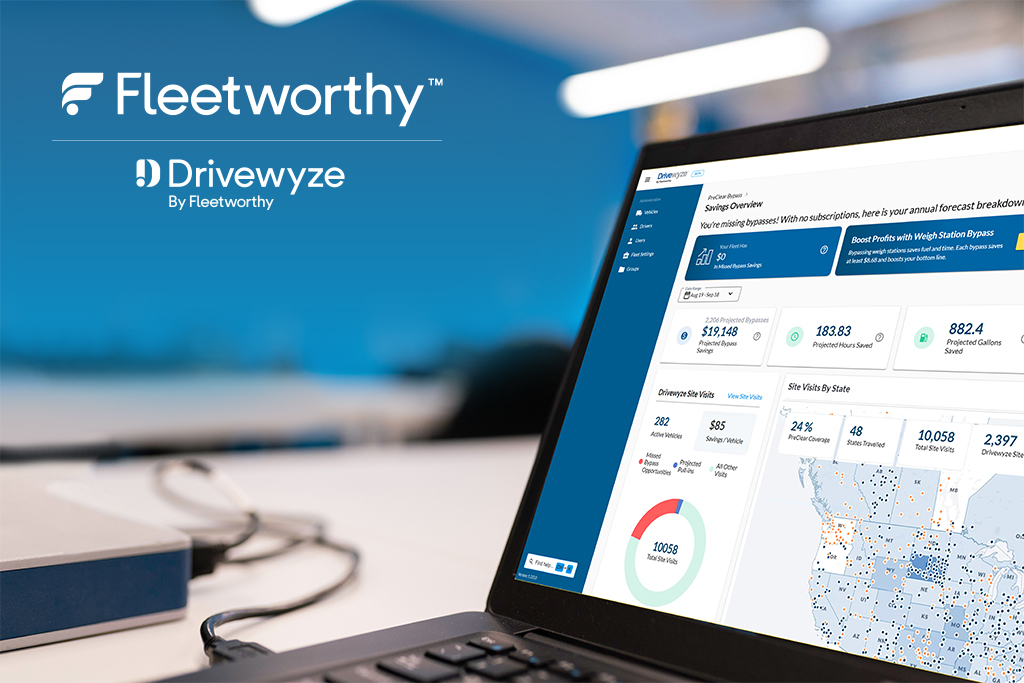Fleet operators are navigating rising fuel costs, driver shortages, regulatory complexity, and the constant demand for real-time visibility across their operations. To stay competitive, businesses are shifting away from traditional systems and embracing more dynamic, scalable solutions. This is where cloud-based fleet management comes into play.
A cloud-based fleet management system offers a transformative approach to overseeing vehicles, drivers, maintenance, and compliance all from a centralized, web-accessible platform. By moving to the cloud, fleets can access critical data in real-time, automate routine tasks, and make informed decisions that enhance both safety and efficiency.
Unlike legacy systems that rely on manual processes or on-premise software, a digital fleet management system empowers fleet managers with 24/7 access to dashboards, alerts, reports, and analytics from anywhere with an internet connection. Whether managing a small regional fleet or a nationwide logistics operation, the right fleet management cloud solution can streamline operations, reduce costs, and improve safety outcomes across the board.
In this article, we’ll explore the key advantages of cloud-based fleet management and outline practical strategies for successful implementation helping your fleet stay ahead in a rapidly evolving industry.
What Is a Cloud-Based Fleet Management System?
Unlike traditional fleet systems that require on-premise hardware and frequent manual data entry, cloud-based solutions use web-based architecture to deliver scalable, always-updated tools that support modern fleet demands.
This architecture allows companies to operate their digital fleet management system entirely online, reducing IT overhead while improving accessibility and data consistency. Fleet managers, dispatchers, safety officers, and even drivers can interact with a single source of truth, whether they’re in the office, on the road, or at a remote job site.
Traditional Systems vs. Cloud Fleet Management
In a traditional setup, fleet data (such as driver logs, maintenance records, and fuel usage) is often siloed across spreadsheets, disparate software, or paper files. Reporting is slow, collaboration is limited, and insights are often only available after the fact. In contrast, cloud fleet management provides a more connected and real-time experience. Updates to vehicle locations, driver behavior, or safety events are captured instantly, enabling proactive decision-making and faster response to emerging issues.
Moreover, cloud-based platforms are continuously updated by the provider, ensuring compliance with evolving regulations, such as FMCSA mandates or Hours of Service (HOS) requirements, without the need for manual patches or upgrades.
Seamless Integration with Telematics and Safety Tools
A core strength of any cloud based fleet management system is its ability to integrate seamlessly with modern telematics and safety technologies. These platforms are typically built to connect with:
- Telematics devices for real-time vehicle diagnostics and performance data
- Electronic Logging Devices (ELDs) for hours-of-service tracking
- GPS systems for location tracking, routing, and geofencing
- Driver behavior tools, including dashcams and ADAS (Advanced Driver Assistance Systems)
- Compliance and safety monitoring solutions, such as CSA score tracking and DQF management systems
By consolidating these inputs into a unified dashboard, a fleet management cloud solution eliminates data silos and provides a holistic view of fleet operations. This integration is foundational for more advanced features discussed in later sections such as predictive analytics, compliance automation, and KPI tracking.
Advantages of Fleet Management System in the Cloud
Adopting a cloud based fleet management system isn’t just a tech upgrade; it’s a strategic shift that offers measurable improvements across efficiency, compliance, safety, and cost control. Below are the key advantages that make cloud fleet management the new standard for modern fleets.
Real-Time Visibility and Control
One of the most significant advantages of a cloud-based fleet management system is the ability to monitor vehicles, assets, and drivers in real-time. Fleet managers can track locations, route deviations, driver behavior, and vehicle health through a centralized dashboard. This instant access to live data enables quicker decisions, more accurate dispatching, and faster response to on-the-road incidents, reducing downtime and improving customer service.
Scalability Across Locations and Vehicle Types
Whether you manage a fleet of 10 vehicles or 10,000, a fleet management cloud solution scales with your business. There’s no need for new hardware or complex IT infrastructure to support expansion. Adding new users, vehicles, or terminals is as simple as updating your subscription or permissions. This flexibility is especially valuable for companies operating across multiple regions or managing mixed fleets with varying compliance needs.
Cost-Efficiency Through Reduced Infrastructure and Maintenance
Traditional systems often require significant upfront investment in servers, software licenses, and IT personnel. A digital fleet management system hosted in the cloud significantly reduces this burden. Fleets can reduce capital expenditures and switch to a predictable subscription-based pricing model. Additionally, automatic updates and vendor-managed maintenance ensure the system remains current without requiring internal IT resources.
Data Centralization for Compliance, Reporting, and Analytics
Compliance with FMCSA, DOT, and internal safety policies requires accurate, up-to-date data. A cloud based fleet management system centralizes information such as driver logs, vehicle inspections, maintenance records, and safety scores in one accessible platform. This not only simplifies audits and reporting but also enables advanced analytics that support proactive decision-making, such as identifying high-risk drivers or vehicles due for preventive maintenance.
Enhanced Security and Reliable Backups
Cloud platforms typically offer enterprise-grade security, including encryption, role-based access control, and multi-factor authentication. In contrast to local systems that are vulnerable to physical damage or data loss, cloud fleet management solutions maintain automatic backups in secure data centers. This ensures continuity and protection of sensitive fleet data even in the event of system failures or cyber threats.
Integration with Maintenance, HR, and Safety Systems
A modern fleet management cloud solution is not a standalone tool it’s an integrated ecosystem. These systems can connect seamlessly with third-party platforms like:
- Maintenance management software for automated service scheduling
- HR systems for driver qualification file (DQF) tracking and training records
- Safety platforms for driver scorecards, incident logs, and policy compliance
This level of integration reduces manual entry, improves accuracy, and enables a more unified view of fleet operations, helping organizations align their teams around shared performance and safety goals.
Implementation Strategies for Cloud Fleet Management
Transitioning to a cloud based fleet management system can deliver significant benefits, but the success of that transition depends on thoughtful planning and execution. Below is a structured, step-by-step approach to help fleets implement a digital fleet management system with minimal disruption and maximum impact.
Step 1: Assess Operational Needs and Objectives
Before selecting a system, it’s essential to understand your fleet’s specific challenges and priorities. Are you aiming to reduce maintenance-related downtime? Improve driver behavior? Simplify compliance? Conducting a full audit of your current processes, pain points, and future goals will help define your requirements for a cloud-based solution.
This assessment should also consider:
- Fleet size and growth projections
- Regulatory compliance needs (e.g., FMCSA, DOT)
- Integration requirements with existing systems
- User access levels and permissions across departments
Clarity at this stage ensures that the chosen platform aligns with your operational goals and scales as your fleet evolves.
Step 2: Evaluate Cloud Vendors and System Compatibility
Not all cloud solutions are created equal. When evaluating providers, look for a cloud based fleet management system that offers:
- Robust security features (encryption, backups, compliance support)
- Integration with telematics, ELDs, GPS, and safety tools
- Mobile access for drivers and remote users
- Real-time data syncing and reporting capabilities
- Responsive customer support and system uptime guarantees
Compatibility with your existing tools, such as HR software, maintenance platforms, or payroll systems is critical. A digital fleet management system should enhance your tech stack, not create new silos.
Step 3: Plan for Data Migration and Integration
Once a solution is selected, plan a structured migration process. This includes transferring:
- Driver qualification files (DQFs)
- Vehicle maintenance records
- Past telematics or route data
- Safety and compliance logs
Clean, well-organized data ensures the system delivers accurate insights from day one. Work with your vendor to schedule phased rollouts if needed, especially for larger fleets. Don’t forget to establish clear integrations with third-party tools, such as maintenance software, fuel cards, and driver training platforms.
Step 4: Train Users and Establish Change Management
Technology only delivers results if people use it correctly. Create a training plan tailored to the different roles, including dispatchers, safety managers, technicians, and drivers. Provide resources such as:
- Onboarding guides
- Hands-on demos
- Video tutorials
- Ongoing support channels
Equally important is change management. Communicate the “why” behind the move to a fleet management cloud solution and how it will benefit both staff and drivers. Encourage feedback early and often to build engagement and trust.
Step 5: Monitor Performance with KPIs
Post-implementation, define and track key performance indicators (KPIs) that align with your fleet’s goals. Common metrics include:
- Maintenance-related downtime
- Accidents per million miles
- Fuel efficiency per vehicle
- Driver safety scores
- Hours-of-service violations
- Compliance audit readiness
A cloud based fleet management system offers real-time dashboards and automated reporting, allowing continuous performance tracking. Use this data to identify improvement areas, adapt training, and ensure long-term ROI.
Common Challenges and How to Overcome Them
While the transition to a cloud based fleet management system offers substantial benefits, it’s not without its challenges. Understanding these obstacles ahead of time and planning for how to address them can ensure a smoother implementation and long-term success with your digital fleet management system.
Data Privacy and Cybersecurity Concerns
For many fleets, storing sensitive operational and driver data in the cloud raises legitimate concerns about data breaches and compliance with privacy regulations. Cyberattacks targeting transportation infrastructure are on the rise, making security a top priority.
How to Overcome It:
Choose a cloud vendor with proven, enterprise-grade security measures. Look for:
- End-to-end encryption
- Multi-factor authentication
- Role-based access controls
- Regular third-party security audits
- Compliance with standards like ISO 27001 or SOC 2
It’s also essential to train internal staff on data privacy best practices and to clearly define user roles to prevent unauthorized access.
Resistance to Change Among Drivers or Admins
Change, especially when it involves technology, can create anxiety or resistance among employees. Drivers may worry about increased monitoring, while administrators may feel overwhelmed by the need to learn a new system.
How to Overcome It: Early engagement is key. Involve team members in the evaluation process so they feel heard and included. Provide hands-on training that’s tailored to different user roles, and highlight how the cloud fleet management system will simplify their jobs, not complicate them. Offering ongoing support, recognizing quick adopters, and reinforcing the benefits (e.g., less paperwork, improved scheduling) can go a long way in easing the transition.
Integration with Legacy Systems
Many fleets still rely on legacy technologies for HR, accounting, maintenance, or routing. Integrating these systems with a new cloud based fleet management system can be technically complex and resource-intensive.
How to Overcome It: Before implementation, perform a full inventory of your existing tools and identify potential integration points. Work closely with your software vendor to ensure the new system supports open APIs and is compatible with your existing infrastructure. If full integration isn’t immediately possible, consider phased rollouts or middleware solutions that bridge data between platforms.
Bandwidth and Connectivity Issues in Remote Areas
Cloud solutions rely on internet access to deliver real-time data and system functionality. For fleets operating in rural or remote regions, unreliable connectivity can hinder access to the digital fleet management system.
How to Overcome It: Select a platform with offline functionality or data caching capabilities that allow drivers and field teams to continue using essential features during connectivity gaps. When a connection is restored, the system should automatically sync data.
The Future of Cloud Based Fleet Management
As fleets continue to digitize their operations, cloud-based systems are poised to evolve even further, transforming from data platforms into proactive, intelligent command centers. Emerging technologies are enhancing how fleets anticipate risks, prevent accidents, and automate decisions at scale. Below are three major trends shaping the future of cloud based fleet management.
The Role of AI and Predictive Analytics
Artificial intelligence (AI) and machine learning are becoming foundational to modern fleet operations. These technologies enable cloud fleet management platforms to move beyond reactive reporting and deliver real-time insights and forward-looking recommendations.
Predictive analytics uses historical data from telematics, maintenance logs, driver behavior, and environmental conditions to:
- Forecast vehicle failures before they happen
- Identify drivers at risk of unsafe behavior
- Recommend optimal routes based on weather, traffic, and load type
- Anticipate regulatory violations before audits occur
By integrating AI models directly into a digital fleet management system, fleets can automate routine decisions, reduce downtime, and intervene early to prevent safety and compliance issues, transforming raw data into proactive risk mitigation.
Integration with Autonomous Safety Systems and ADAS
The integration of Advanced Driver Assistance Systems (ADAS) and semi-autonomous safety features is becoming more prevalent, particularly in medium and heavy-duty commercial vehicles. These systems provide real-time alerts for lane departures, forward collisions, blind spots, and driver drowsiness.
What’s changing is how these systems interface with cloud platforms. Modern cloud based fleet management systems now ingest ADAS data alongside telematics, giving safety managers deeper visibility into both machine-assisted interventions and driver responsiveness.
As autonomous technologies continue to evolve, we can expect even more robust integrations, such as:
- Real-time risk scoring based on ADAS event frequency
- Automated coaching triggered by near-miss detections
- Data-sharing between fleet systems and OEM safety platforms
- Centralized dashboards that monitor autonomous feature usage and override rates
This convergence will play a key role in reducing preventable accidents and streamlining driver safety programs.
Unified Platforms for Safety, Compliance, Routing, and Maintenance
The future of fleet operations lies in platform unification. Instead of juggling multiple disconnected systems, one for routing, another for compliance, a third for maintenance, fleets are moving toward single-source platforms that combine all major operational functions.
Leading fleet management cloud solutions are already offering this level of integration, combining:
- Real-time vehicle tracking and route optimization
- Automated maintenance scheduling and diagnostic alerts
- Compliance management tools (e.g., ELDs, DQFs, DVIRs)
- Driver behavior monitoring and performance scoring
- Safety alerts, event-based video, and training workflows
This unified approach not only reduces complexity but also enhances operational intelligence. With every system feeding into a centralized platform, fleets gain a more complete picture of performance, enabling faster decisions, better resource allocation, and tighter alignment across departments.
Conclusion
As the transportation and logistics landscape becomes increasingly complex, adopting a cloud-based fleet management system is no longer just a competitive advantage; it’s a strategic necessity. These platforms empower fleets to operate with greater agility, transparency, and control, offering real-time data, seamless integration, and predictive intelligence that traditional systems simply can’t match.
Looking ahead, the future of digital fleet management systems will be defined by AI, automation, and platform unification. Fleets that embrace these advancements now will be better positioned to optimize performance, reduce risk, and stay ahead of evolving industry demands.
In short, cloud fleet management isn’t just about managing vehicles; it’s about enabling smarter, safer, and more strategic fleet operations. By investing in cloud innovation today, fleet leaders can drive lasting improvements in efficiency, compliance, and safety for years to come.
Frequently Asked Questions (FAQ)
What are the advantages of cloud fleet management?
Cloud fleet management offers numerous advantages over traditional, on-premise systems. With a cloud-based fleet management system, fleets gain real-time visibility into vehicle performance, driver behavior, and maintenance needs, all from a centralized platform accessible from anywhere. These systems are scalable, secure, and cost-efficient, reducing the need for physical infrastructure and manual data entry.
Key benefits include:
- Instant access to live data and alerts
- Automated reporting for safety and compliance
- Reduced downtime through predictive maintenance
- Centralized data for easier audits and performance tracking
- Seamless integration with telematics, GPS, and ELDs
By adopting a fleet management cloud solution, operators can streamline operations, cut costs, and significantly improve fleet safety and efficiency.
How does a digital fleet management system improve compliance?
A digital fleet management system improves compliance by automating and centralizing key regulatory processes. These platforms are designed to support FMCSA and DOT requirements, including Hours of Service (HOS), electronic logging, vehicle inspections, and driver qualification files (DQFs).
Here’s how it helps:
- Automatically logs and stores HOS data via integrated ELDs
- Tracks DVIRs, preventive maintenance schedules, and inspection history
- Flags expired licenses, missing documentation, or CSA violations
- Provides real-time dashboards for compliance officers and safety managers
- Generates audit-ready reports with a single click
Because everything is managed digitally and in real time, fleets can proactively address issues before they lead to violations, making compliance both more reliable and less resource-intensive.




